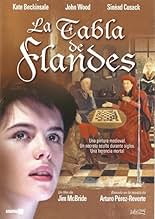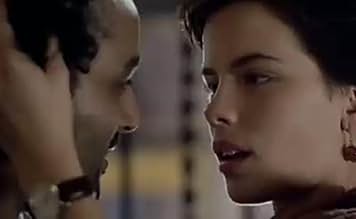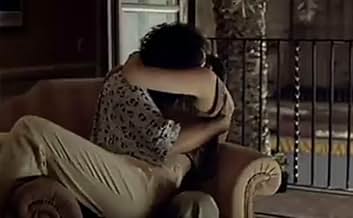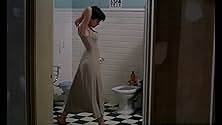VALUTAZIONE IMDb
5,7/10
2946
LA TUA VALUTAZIONE
Aggiungi una trama nella tua linguaA woman finds a hidden message in a restored painting questioning a knight's death. When her friend is murdered investigating it, a chess game's moves in the painting link to killings from t... Leggi tuttoA woman finds a hidden message in a restored painting questioning a knight's death. When her friend is murdered investigating it, a chess game's moves in the painting link to killings from the past that she must solve.A woman finds a hidden message in a restored painting questioning a knight's death. When her friend is murdered investigating it, a chess game's moves in the painting link to killings from the past that she must solve.
- Regia
- Sceneggiatura
- Star
Sinéad Cusack
- Menchu
- (as Sinead Cusack)
Julian Martínez
- Duke Ferdinand
- (as Julián Martínez)
Isabel van Unen
- Beatrix of Burgundy
- (as Isabel Van Unen)
Josuè Guasch
- Messenger
- (as Josue Guasch)
Recensioni in evidenza
This is a worthwhile experience, despite all the many flaws the film has. It's a weak work in most of the skills you may think of, related to film technique, and film expression:
The acting is childish, this applies to practically every participant. Exception made to Beckinsale, she moves around in a naive boyish manner, but she distills sex, she is that character who concentrates attentions, without being excessively aware of that. She does it well. The rest of the acting is weak. The editing doesn't help as well. The premises for the montage work in a film such as this one weren't so hard to follow. They just had to tell physical actions, linear and common. Yet there are transitions, basic continuity problems that aren't solved, expressions in the faces that change, and so on. The music is also not well placed, it's a bad soundtrack in its own musical value, but above all in the mood that transmits. The tribal references weren't needed, and in the kind of story depicted, noir influenced, it would have been nice to have the music link the sets and evolutions in the story line.
But there are three things for which i think this is worth taking a look. One is the narrative structure, how the story moves on. This is based on a novel by Pérez-Reverte, the man who also wrote Ninth Gate. So we have a merging of art and life, the story happening in front of us was "written" or at least determined many years ago, buy an artist, in this case a painter. The first scene is masterful in transmitting this, really it was one of the most economic and meaningful first scenes i saw ever. It basically starts with a closeup of a hand in a painting (a hand as a synonym for power, ability to do things), and the camera moves away from the painting (it moves, it's not a zoom out)and we get to see the border of the painting fully merged with the "real" environment surrounding it. This illusion of merger works for a few moments after which we get into the environment and momentarily forget the painting. This really works.
Other thing is the use of House Batló, by Gaudi. It's interesting how the camera (and the editing) lies about the building, to enhance it's qualities. It's not a particularly brilliant exploration of the space, but it's quite competent: what happens is, we get Beckinsale going up the stairs that lead to the first floor, she rings the bell in that first floor. These stairs are beautiful, they curve like the back of an animal, you get the sensation of elevation, instead of going up. Than this is edited and the inner space we get is from inside the attic, which is built with bows that remind an animal spine and bones. Later in the film, we have an outside establishing shot that leads the camera, from the outside, all the way up to the attic. We understand that the character lives in the attic, not in the first floor. This was interesting and showed a specific interest in playing with the house. A side note is that this film is a good opportunity for you to check the great ground floor of the house, which is today polluted by the bars which conduct the tourists, and the tourists themselves, lining up to get in, and filling the sidewalk around. Pity. I have a theory that tourism is literally killing and sucking life out of our best places in the world, but this is another discussion.
Anyway, the touristic gaze can also be seen in the shots that depict the city. Here we also get lies, usually related to the intention of getting the establishing shots. Here i think they messed up. They didn't have to show all the known places all the time. There are fantastic relatively hidden places in that city that show more of its mood and life than the monuments. One of those places is actually used, the St Antoni market (the protagonist lives in front of it). The place is alive, and they use it well in some scenes. But than they lie about the city, so we have her going from Batló, to Rambla, to the Temple, to the market as if they were close enough to walk to, one after the other, sequenced like i said. It's a lie, i have nothing against it, but i have against making the postcard taking nothing useful out of it. A good use of common architecture is the one made with Beckinsale's house, especial its central stairs, and central lifter. The use of Park Guëll is not particularly interest, except for some movement between columns, but that's it. And in that movement, they inserted some staged flirting between couples. Very poor, very artificial, they didn't need to do it, the park has an interesting life on its own.
My opinion: 3/5
http://www.7eyes.wordpress.com
The acting is childish, this applies to practically every participant. Exception made to Beckinsale, she moves around in a naive boyish manner, but she distills sex, she is that character who concentrates attentions, without being excessively aware of that. She does it well. The rest of the acting is weak. The editing doesn't help as well. The premises for the montage work in a film such as this one weren't so hard to follow. They just had to tell physical actions, linear and common. Yet there are transitions, basic continuity problems that aren't solved, expressions in the faces that change, and so on. The music is also not well placed, it's a bad soundtrack in its own musical value, but above all in the mood that transmits. The tribal references weren't needed, and in the kind of story depicted, noir influenced, it would have been nice to have the music link the sets and evolutions in the story line.
But there are three things for which i think this is worth taking a look. One is the narrative structure, how the story moves on. This is based on a novel by Pérez-Reverte, the man who also wrote Ninth Gate. So we have a merging of art and life, the story happening in front of us was "written" or at least determined many years ago, buy an artist, in this case a painter. The first scene is masterful in transmitting this, really it was one of the most economic and meaningful first scenes i saw ever. It basically starts with a closeup of a hand in a painting (a hand as a synonym for power, ability to do things), and the camera moves away from the painting (it moves, it's not a zoom out)and we get to see the border of the painting fully merged with the "real" environment surrounding it. This illusion of merger works for a few moments after which we get into the environment and momentarily forget the painting. This really works.
Other thing is the use of House Batló, by Gaudi. It's interesting how the camera (and the editing) lies about the building, to enhance it's qualities. It's not a particularly brilliant exploration of the space, but it's quite competent: what happens is, we get Beckinsale going up the stairs that lead to the first floor, she rings the bell in that first floor. These stairs are beautiful, they curve like the back of an animal, you get the sensation of elevation, instead of going up. Than this is edited and the inner space we get is from inside the attic, which is built with bows that remind an animal spine and bones. Later in the film, we have an outside establishing shot that leads the camera, from the outside, all the way up to the attic. We understand that the character lives in the attic, not in the first floor. This was interesting and showed a specific interest in playing with the house. A side note is that this film is a good opportunity for you to check the great ground floor of the house, which is today polluted by the bars which conduct the tourists, and the tourists themselves, lining up to get in, and filling the sidewalk around. Pity. I have a theory that tourism is literally killing and sucking life out of our best places in the world, but this is another discussion.
Anyway, the touristic gaze can also be seen in the shots that depict the city. Here we also get lies, usually related to the intention of getting the establishing shots. Here i think they messed up. They didn't have to show all the known places all the time. There are fantastic relatively hidden places in that city that show more of its mood and life than the monuments. One of those places is actually used, the St Antoni market (the protagonist lives in front of it). The place is alive, and they use it well in some scenes. But than they lie about the city, so we have her going from Batló, to Rambla, to the Temple, to the market as if they were close enough to walk to, one after the other, sequenced like i said. It's a lie, i have nothing against it, but i have against making the postcard taking nothing useful out of it. A good use of common architecture is the one made with Beckinsale's house, especial its central stairs, and central lifter. The use of Park Guëll is not particularly interest, except for some movement between columns, but that's it. And in that movement, they inserted some staged flirting between couples. Very poor, very artificial, they didn't need to do it, the park has an interesting life on its own.
My opinion: 3/5
http://www.7eyes.wordpress.com
A truly bad movie, from a generally good director like Jim McBride (I loved "Great Balls of Fire"). Based on a novel from Perez Reverte, this film is dull and uninteresting, and the only thing you can recommend from it is a nude scene from Kate Beckinsale (48 minutes after the start, so press your fast forward button in your video).
A young art restoration specialist based in Barcelona is retained by an art gallery to restore a 17th century Dutch Masters paainting that has been in a private collection since it was created. The painting depicts an elderly nobleman playing cards with a younger man, while a noblewoman watches in the backgrounnd. All restorations include an xray, and this image reveals an underlying original painting on the same two men playing chess instead of cards. On the lower right, in Latin, are the words "Who Killed the Knight." The film reveals the names of the people in the painting, their relationships to each other, and how they relate to the current owners.
This is a reasonably suspenseful film with qhite a few surprises. The performances are ot bad, although Kate Beckensale's inexperience is glaring. The story, however, more than compensates for this modest short coming, and the sight of the scantily clad beautiful English actress at age 21 is quite breathtaking.
This is a reasonably suspenseful film with qhite a few surprises. The performances are ot bad, although Kate Beckensale's inexperience is glaring. The story, however, more than compensates for this modest short coming, and the sight of the scantily clad beautiful English actress at age 21 is quite breathtaking.
Julia (Kate Beckinsale) is a restorer working in a five hundred years old painting, which theme is a chess game: there are two men playing chess and a woman watching them. This painting will be sold in an auction after the restoration, and the amount will be split among the owner, an old man who lost his wealthy, Julia's best friend Menchu (Sinéad Cusack) and her partner. Max and Lola, relatives of the owner, are very interested in the selling. Julia has no family and was raised by Cesar (John Wood), who has a fraternal love for her. Cesar is also homosexual. Julia finds a hidden message in Latin in the paint, an after some investigation, she finds out that the translation would be `Who killed the knight?' Soon, many characters are associated to the pieces of the chess and are killed, following the movements of the game in the painting. This incredible and complex plot is a great disappointment. One of the attraction is Kate Beckinsale in the beginning of her career, with a beautiful body and breasts, but with a rough and common face. Presently, nine years older than in this movie, she is very gorgeous, very well produced in her films, with a delicate face, thin nose, beautiful and long hair and wonderful costumes. My vote is five.
A young Kate Beckinsale barely 20 years old during principal photography (which began one week after her 20th birthday, 2 august 1993), stars as the ingenue protagonist in this light murder mystery. We immediately and easily glean that this is indeed inténded to be a light hearted lowbrow movie, from the cheery musical score which is incessant and at times quite annoying.
Beckinsale plays Julia Darro, a restorer of paintings in Barcelona, who gets a job to restore a 500 year old painting, by the fictitious painter Van Huys (sounds like Van Nuys .... from the boulevard ... get it?) from Flanders, so, not a true Dutch Master but something close to it. She discovers that the painting contains a hidden, painted over message in Latin: "Quis Necavit Equitem" or "Who Killed the Knight?". What unfolds is a who-dunnit with some plot twists, but since they eventually kill off all possible suspects, when we get near the end, it's pretty clear who is the culprit.
Now, miss Beckinsale bravely shows some skin in this movie but, there have been numerous women who done that before her and at a younger age at that. Of the 260+ actresses in this 18-21 age group, Amber Heard, Barbara Capell, Charlotte Alexandra, Charlotte Walior, Clémence Poésy, Donna Wilkes, Georgina Cates, Hayley Mills, Heather Langenkamp, Helena Bonham Carter, Jacqueline Byers, Katie Holmes, Lizzie Brocheré, Mathilda May, Melanie Griffith, Odile Michel, Romane Bohringer, Tamara Mello come to mind, and those are just the ones that were of legal, non-Brooke Shields age, so to speak. But what makes her truly braver than her younger collegueas, are two things that stand out: She has the lips of Art Malik touching her breasts and ... she shows some truly hairy armpits somewhat later .... I found that last one to be especially shocking, since "even" French actressess haven't done that since the 70s. And they dó get a bad rep on the whole hairy armpits thing anyway.
The lightness of the movie is fully intentional, so much of the whining that it doesn't do the book justice is wholly irrelevant. And I get the feeling that much of the negative reviews come from .... let's call them ... the "Cesar Belvedere"-side of the spectrum. Which is odd, because John Wood (what's in a name) is actually one of the excellent aspects of this movie. Even.
Oh well. This movie is like Back to the Future, and all JCVD movies: they are excellent in their respective genres. So, don't go comparing this to "They shoot horses, don't they?" That's nonsensical. If you think this movie hurts the book, get the funding and make one yourself.
7/10.
The Melancholic Alcholic.
Beckinsale plays Julia Darro, a restorer of paintings in Barcelona, who gets a job to restore a 500 year old painting, by the fictitious painter Van Huys (sounds like Van Nuys .... from the boulevard ... get it?) from Flanders, so, not a true Dutch Master but something close to it. She discovers that the painting contains a hidden, painted over message in Latin: "Quis Necavit Equitem" or "Who Killed the Knight?". What unfolds is a who-dunnit with some plot twists, but since they eventually kill off all possible suspects, when we get near the end, it's pretty clear who is the culprit.
Now, miss Beckinsale bravely shows some skin in this movie but, there have been numerous women who done that before her and at a younger age at that. Of the 260+ actresses in this 18-21 age group, Amber Heard, Barbara Capell, Charlotte Alexandra, Charlotte Walior, Clémence Poésy, Donna Wilkes, Georgina Cates, Hayley Mills, Heather Langenkamp, Helena Bonham Carter, Jacqueline Byers, Katie Holmes, Lizzie Brocheré, Mathilda May, Melanie Griffith, Odile Michel, Romane Bohringer, Tamara Mello come to mind, and those are just the ones that were of legal, non-Brooke Shields age, so to speak. But what makes her truly braver than her younger collegueas, are two things that stand out: She has the lips of Art Malik touching her breasts and ... she shows some truly hairy armpits somewhat later .... I found that last one to be especially shocking, since "even" French actressess haven't done that since the 70s. And they dó get a bad rep on the whole hairy armpits thing anyway.
The lightness of the movie is fully intentional, so much of the whining that it doesn't do the book justice is wholly irrelevant. And I get the feeling that much of the negative reviews come from .... let's call them ... the "Cesar Belvedere"-side of the spectrum. Which is odd, because John Wood (what's in a name) is actually one of the excellent aspects of this movie. Even.
Oh well. This movie is like Back to the Future, and all JCVD movies: they are excellent in their respective genres. So, don't go comparing this to "They shoot horses, don't they?" That's nonsensical. If you think this movie hurts the book, get the funding and make one yourself.
7/10.
The Melancholic Alcholic.
Lo sapevi?
- QuizHelen McCrory's debut.
I più visti
Accedi per valutare e creare un elenco di titoli salvati per ottenere consigli personalizzati
- How long is Uncovered?Powered by Alexa
Dettagli
- Data di uscita
- Paesi di origine
- Lingue
- Celebre anche come
- La tabla de Flandes
- Luoghi delle riprese
- Aziende produttrici
- Vedi altri crediti dell’azienda su IMDbPro
- Tempo di esecuzione1 ora 43 minuti
- Colore
- Mix di suoni
- Proporzioni
- 1.66 : 1
Contribuisci a questa pagina
Suggerisci una modifica o aggiungi i contenuti mancanti

Divario superiore
By what name was Scacco matto (1994) officially released in India in English?
Rispondi


























